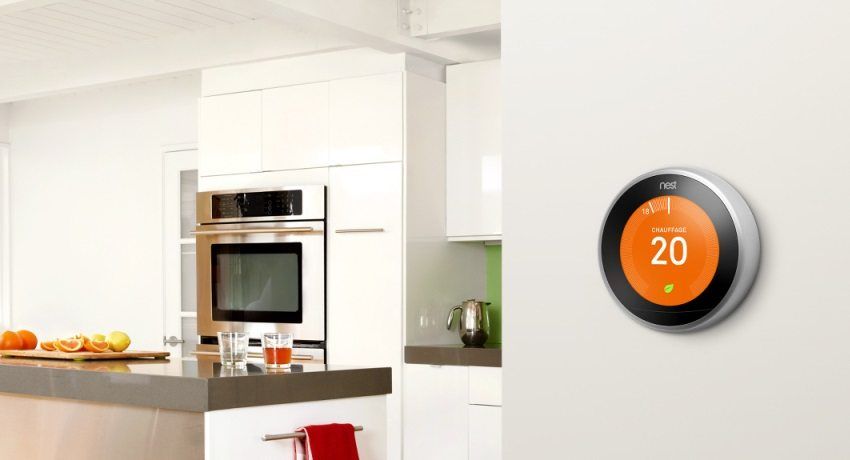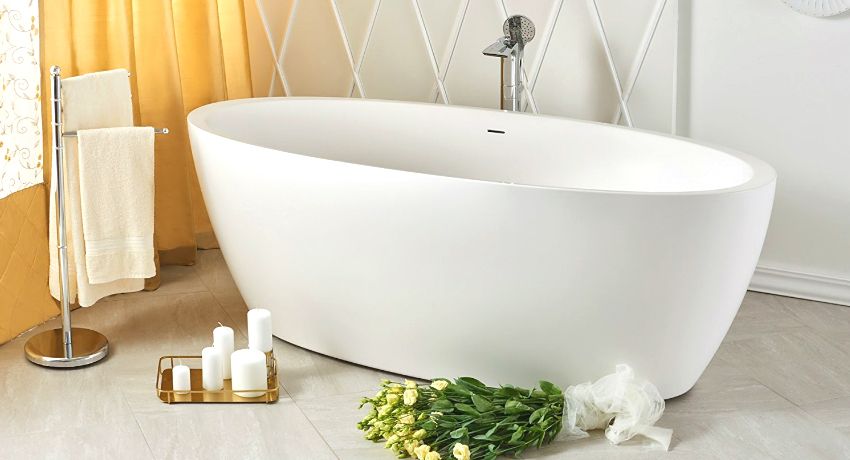Properly selected hood is able to clean the air from harmful impurities and unpleasant odors that are formed in the process of cooking. Modern manufacturers offer a wide range of exhaust devices, different in type, mode of operation, functions and design. The most popular option is a built-in hood for the kitchen, which occupies a minimum of space, which is so important for small spaces.

What is a built-in kitchen hood
Hood is a unique invention that is capable of trapping fat, fumes, soot and odors while cooking in the kitchen, preventing them from spreading throughout the apartment and settling on kitchen furniture and walls.
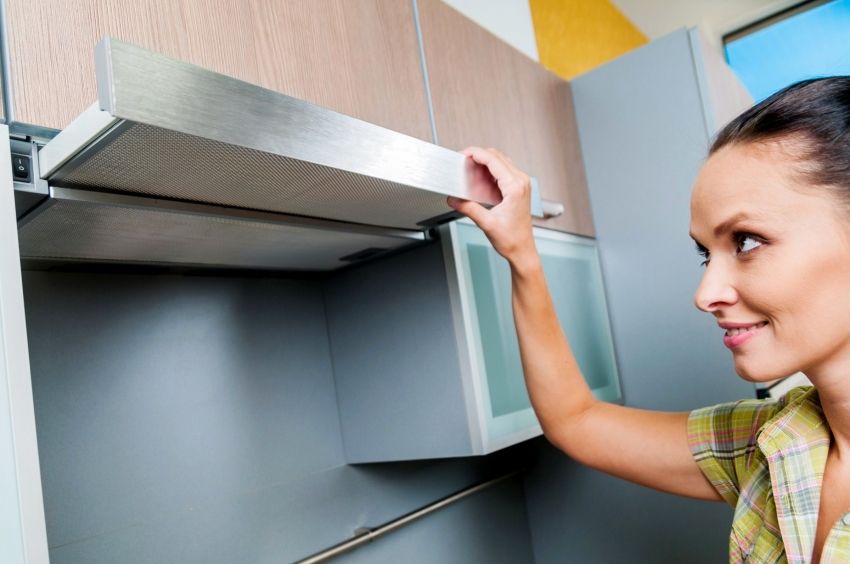
Any hood works on the principle of forced ventilation. Catching polluted air, it passes it through a filter installed inside the device, and thereby cleans it from grease, soot, combustion products and unpleasant odors. Purified air flows back into the room (during recirculation mode of operation) or is discharged into the ventilation shaft (when arranging a kitchen hood with a vent to ventilation).
The filters that each exhaust model is equipped with, regardless of the manufacturer and type of device, are located inside the device case. A control module with an electronic, mechanical or slider panel is placed on its frontal part.
All modern hoods differ in how they are mounted on: recessed, domed and suspended.
Built-in kitchen hood is the most popular and sought after. It is mounted inside the wall cabinet, which is located above the hob or in the worktop. This allows you to hide the device, which gives the kitchen completeness and harmony.
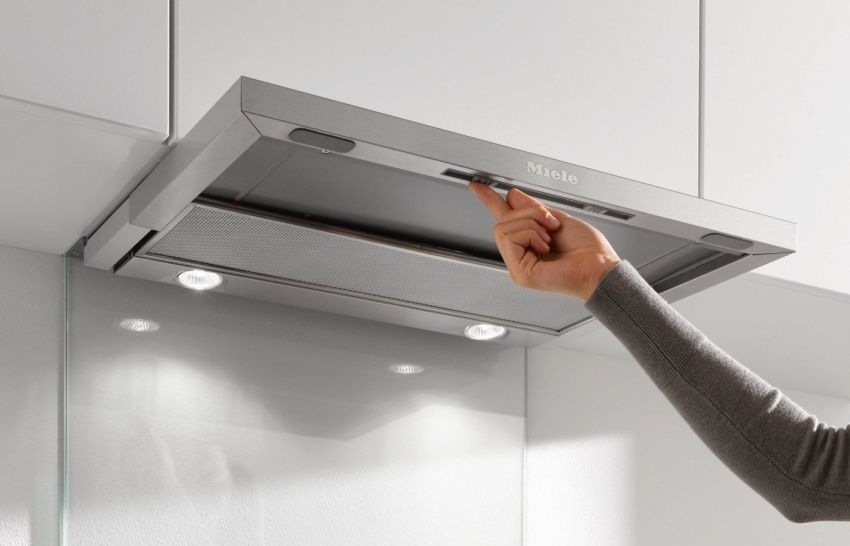
Built-in hoods can be vertical or horizontal.
Helpful advice! Vertical hood in its parameters is not inferior to the dome. However, it is more compact and convenient to operate.
All models of built-in hoods differ in certain parameters.
The first parameter to pay attention to is the size of the hood and the design of the sliding module. Built-in hood is completely hidden in a wall cabinet, which has no bottom. The working area of the hood can be increased with a sliding screen.
If the kitchen set is already installed, then the device is selected on the basis of the internal space of the wall cabinet where it will be located. Hoods come in various sizes ranging from 45 cm to 90 cm, which does not cause the difficulty to choose the type and size needed for a particular case. However, we should not forget that the size of the hood should be similar to the dimensions of the cooking surface. It is better if the exhaust device covers the cooking surface in its area, and not vice versa.
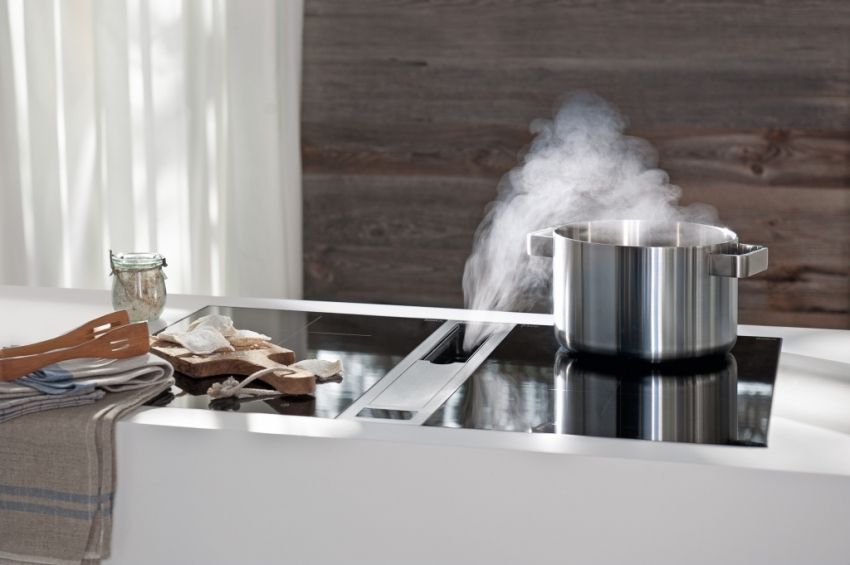
The 45 cm hood that is built into the closet is ideal for small kitchens with an area of 6 square meters. m., where the stove is located on 2-3 burners. Installation in the cabinet built-in hood 45 cm does not imply additional actions associated with the adjustment of the size of furniture.
Similar advantages have built-in kitchen hood 50 cm. Its design is very compact and does not imply any additional steps during installation. At the same time, the performance of the exhaust 50 cm, built-in cabinet, does not exceed 400 cubic meters. m. per hour Therefore, to provide a full cleaning of the kitchen of an average size with an extract of 50 cm wide will not succeed.
Standard sizes of hobs imply the use of built-in kitchen extractor hoods of 60 cm. They are able to provide the necessary performance thanks to powerful engines that are ideal for kitchens with an area of 9 square meters. At the same time, such an extract significantly saves space due to its design.
For a large kitchen area, 12 square meters. m and more, ideal built-in hood for the kitchen 90 cm. It is also installed above the overall stove with 5 burners.

All built-in hoods are equipped with a filtration system. Air purification can occur in one or two stages.
Flow hoods are equipped with a mechanical filtration system without installing a carbon filter. Here the polluted air is cleaned of products of combustion, grease and soot. Most models are equipped with a steel or aluminum filter, which require regular cleaning as they become dirty. It does not require replacement. Its service life is unlimited and reaches the period of operation of the hood. Disposable filters are a replaceable plastic cassette with synthetic filler, which can be sintepon or fleece.
Models that operate in recirculation mode are necessarily equipped with a disposable carbon filter. That he is able to neutralize foreign odors that are formed during cooking. Such a filter require regular replacement. After the end of the operation period, after 3-6 months, which depends on the intensity of the device, it is necessary to replace the carbon filter for the hood, which can be bought at any home appliances store at a price of 1.5 thousand rubles.
Built-in hoods can be with one or two engines. This affects the quality of air purification, device performance and noise level during operation. The more exhaust performance is required, the more powerful the engine will be. And this affects the noise level, which will also be higher. Typically, built-in exhaust hoods are equipped with engines of average power to reduce the overall noise level of the device.
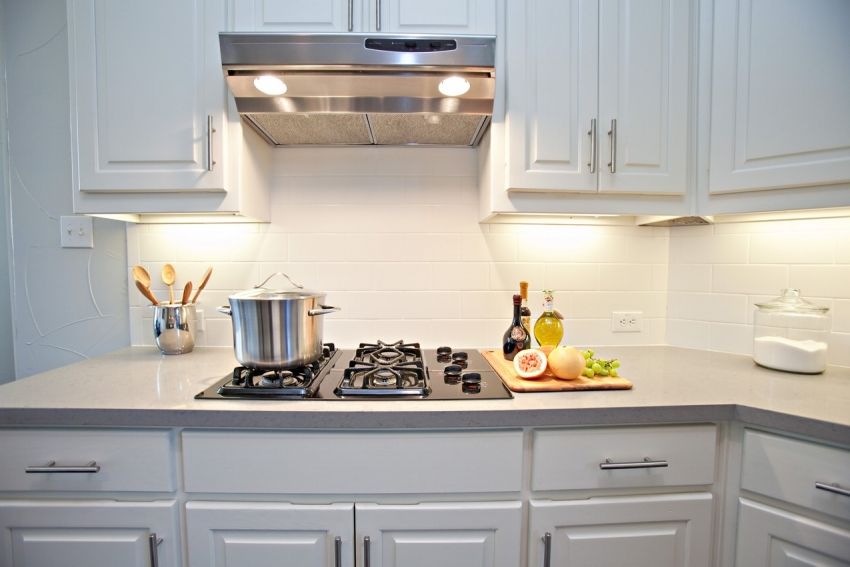
The performance of the device determines the total amount of polluted air that can be cleaned per unit of time. Calculate it is very simple. It is necessary to multiply the volume of the room by a factor of 10 or 12, which indicates the air exchange in the room per hour. This value will correspond to the minimum capacity required for the room.
Helpful advice! To the minimum performance value, add another 20% and select the device based on the obtained value.
On the front of the hood is an electronic module panel that controls the exhaust device. In turn, the panel can be push-button, touch and slider. Regulation of the operating modes of the hood with a button control system is carried out by switching the button. The slider panel suggests moving the mechanical slider to the place corresponding to the required mode of operation. Touch control is carried out by touching your finger on the desired area. When the command is accepted, the LED on the panel lights up.

Modern hoods are equipped with many additional features that are aimed at facilitating their operation and creating additional comfort. The device may have the function of interval switching, due to which the hood periodically independently switches on, ensuring the flow of fresh air into the room. The hood can be with a residual stroke function, which allows the fan to operate for some time after the hood has been switched off. This allows for perfect cleaning of polluted air.
More expensive modern models are equipped with an LCD screen with the ability to connect a DVD player or PC, meteo-system that allows you to display the weather forecast on the display. This is due to the weather station, which is located outside the house, and is connected to the hood.
One of the important criteria by which all models of embedded extracts differ from each other, is the design of the device. There are full, visor and telescopic hoods.
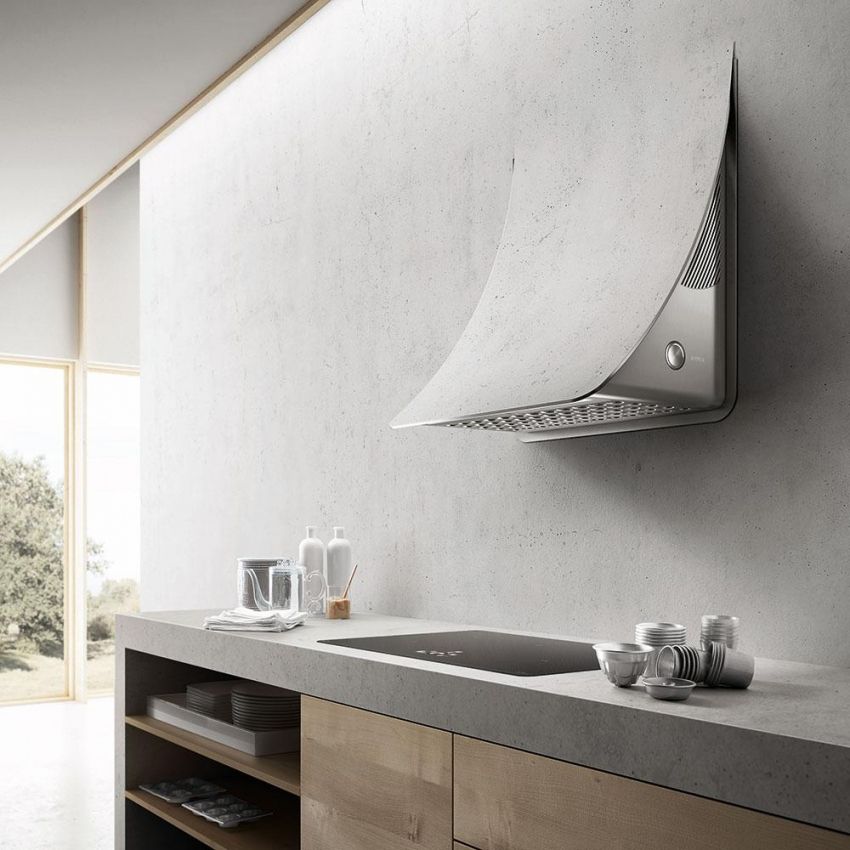
Full built devices are the best suited for small kitchens. The hood is fully mounted in a wall cupboard or countertop, without taking away any free space and without attracting attention, as can be seen in the photo of the built-in hoods that complement any room design. Such a device can be equipped with a carbon filter that will allow the hood to work in recirculation mode.
The design of the telescopic hood involves increasing the working area by pushing the surface of the device forward. This option provides greater exhaust performance and facilitates the management of this device.
All built-in hoods are divided into flow and recirculation. Flowing equipment must be additionally equipped with an air vent that connects the exhaust hood to the air vent. They are more expensive, but have greater productivity. Recirculation hoods pass air through the carbon filter system and return it back to the room. They do not require additional costs for the installation of a ventilation system in the ventilation of the house.

There are models with recirculation mode of operation that are able to ensure efficient operation, however, this entails a high cost of the device and large energy costs associated with its operation.
Helpful advice! For large kitchens, you should choose hoods with air exhaust in the ventilation.
There are models that can work in two modes. Air purification is carried out with the help of a fatty filter, which frees the air from harmful impurities, and the carbon filter copes with an unpleasant smell. Then the purified air can be discharged into the ventilation system through the duct, and can be returned back to the room. Depending on the occupation in the kitchen, you can switch to the desired mode of operation of the device.
Built-in hoods can be mounted in a cabinet or tabletop. If you choose a model that is mounted in the cabinet, you must consider its size and dimensions for embedding. The cabinet must be the same size as the ventilation unit, which in turn must match the size of the hob to ensure maximum capture of polluted air from its work area. The installation of the built-in hood in the cabinet can be easily performed independently. It is enough to fix the device in its lower part with self-tapping screws, and then install the entire hinged structure on the wall.
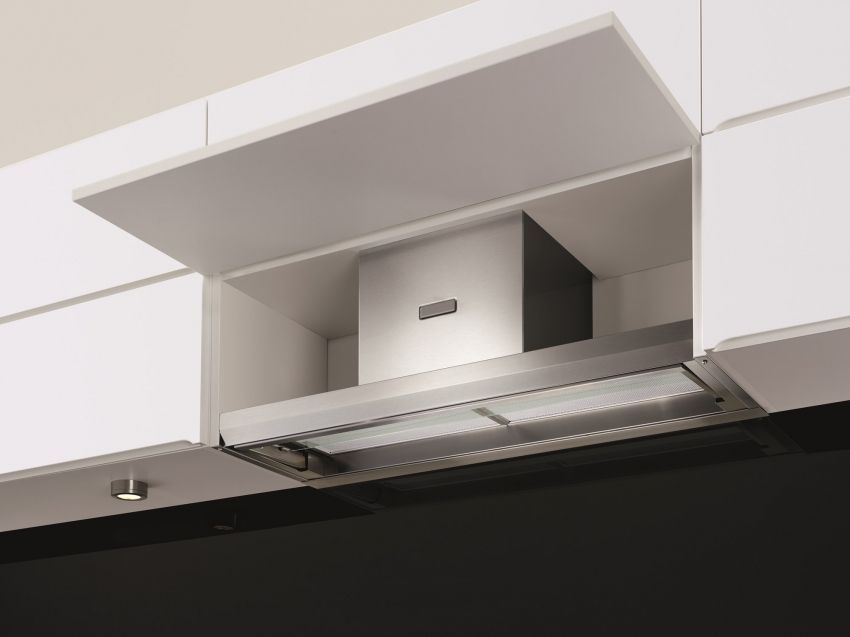
An important rule is to comply with the required height of the hood above the gas stove. The device must be placed at a distance of 75 cm from the gas hob and 65 cm from the electric.
Helpful advice! Do not neglect the established standards. If the exhaust distance above the gas stove is shorter, it may cause overheating of the device and its ignition. And increasing the distance will reduce the quality of air trapping and thus make the exhaust work inefficient.
The hood that is built into the countertop is a wonder. However, such a vertical arrangement of the device allows you not to clutter the upper cabinets in the case of additional installation of the air vent, or not to install them above the stove. The device is installed at an optimal distance from the plate. There are options that are embedded directly in the non-stick coated plate.
One of the best hoods that works in recycling mode is the Elikor Integra 60 model. Consumers say a good combination of an affordable price and high quality of the device. The price of the extract Elikor starts from 2.5 thousand rubles. It is ideal for small-sized kitchens and is able to cope with the purification of air of the declared volume. Productivity of an extract makes 400 m? / Hour.
To choose the built-in hood correctly is not an easy task. The first step is to calculate the required performance. And then, from a number of the proposed models, choose the most suitable option that is ideal for a particular kitchen. Many well-known manufacturers are trying every year to improve their products. Today, you can choose a model of exhaust device that fits perfectly into the interior, will be comfortable and comfortable to use and will cope with air pollution of any concentration of harmful substances, cleaning it to the requirements of the standard.
